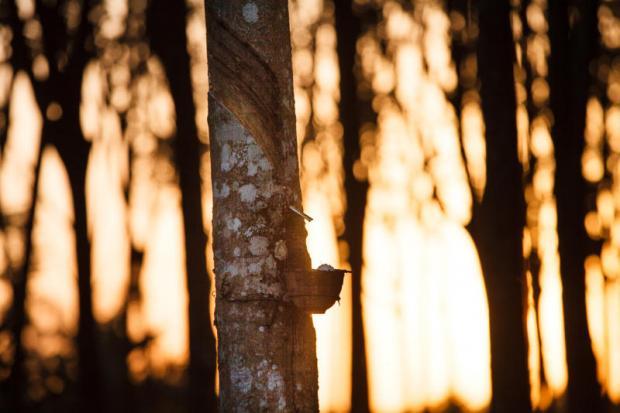Prime Minister Prayut Chan-o-cha gave a mandate yesterday for related agencies to work out strategic plans to upgrade the quality of block rubber and measures to sway farmers from putting sulphuric acid in the latex.

A dispute over the low quality of rubber made in the Northeast and North prompted authorities to outline measures to improve the level of the product. (Photo by Seksan Rojjanametakun)
Titus Suksaard, governor of the Rubber Authority of Thailand, said the premier chaired the National Rubber Policy Committee and instructed responsible agencies including the authority to tackle the sulphuric acid issue after major tyremakers threatened to stop buying rubber from Thai farmers because of its low quality.
Farmers in the North and Northeast normally put a drop of sulphuric acid in the rubber latex to make it coagulate more quickly before selling it as cup lumps to rubber factories.
But the sulphuric acid reduces the flexibility of the rubber, causing problems on processing lines for tyremakers, forcing them to change the substance mixing ratio, which raises production costs.
Mr Titus said the authority for a year has promoted farmers using formic acid, which is an organic and environmentally friendly substance that helps improve the quality of rubber.
Some 60% of rubber farmers still rely on sulphuric acid, while 40% have shifted to formic acid. Formic acid is quoted at 0.32 baht per kilogramme, but sulphuric acid is quoted at 0.15 baht per kg.
He said the authority pledged to offer better prices to farmers who use formic acid. It is also asking for cooperation from related agencies to label products that use formic acid.
The government may need to set aside a subsidy in the short term to attract farmers to use formic acid, Mr Titus said.
Veerasith Sincharoenkul, an executive committee member for Sri Trang Agro-Industry Co, said the company has not stopped buying sulphuric acid cup lumps. Shortly after the tyremaker report, however, networks of rubber farmers in the Northeast threatened to boycott Sri Trang and discourage farmers from buying tyres from Michelin and Bridgestone.
Veerasak Sinthuwong, a key member of the Network of Thai Rubber Farmers, said cup lumps make up 80% of rubber produced in the Northeast and latex accounts for 20%.
Most cup lumps are processed in the form of STR20 rubber, shipped mainly to China. This type of rubber is processed into other products, not tyres.
Mr Veerasak said farmers use sulphuric acid when collecting latex during the rainy season to make it coagulate more quickly, otherwise the latex would be damaged if rainwater contaminated it.





























